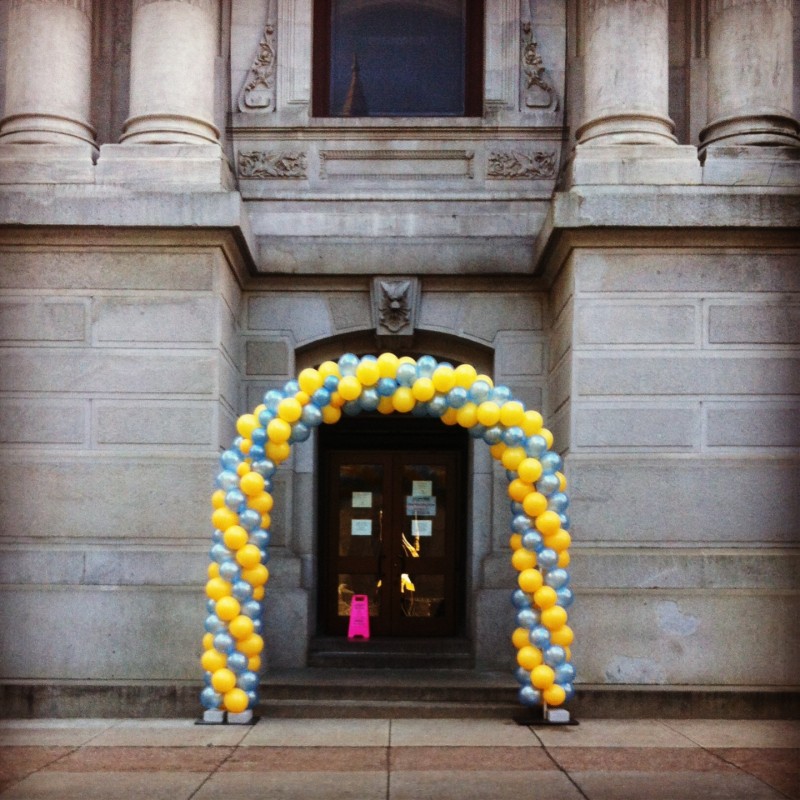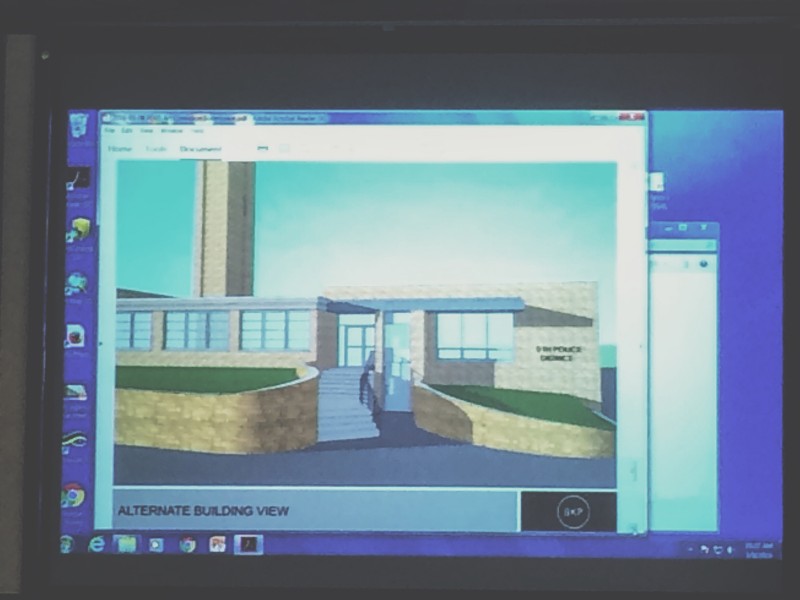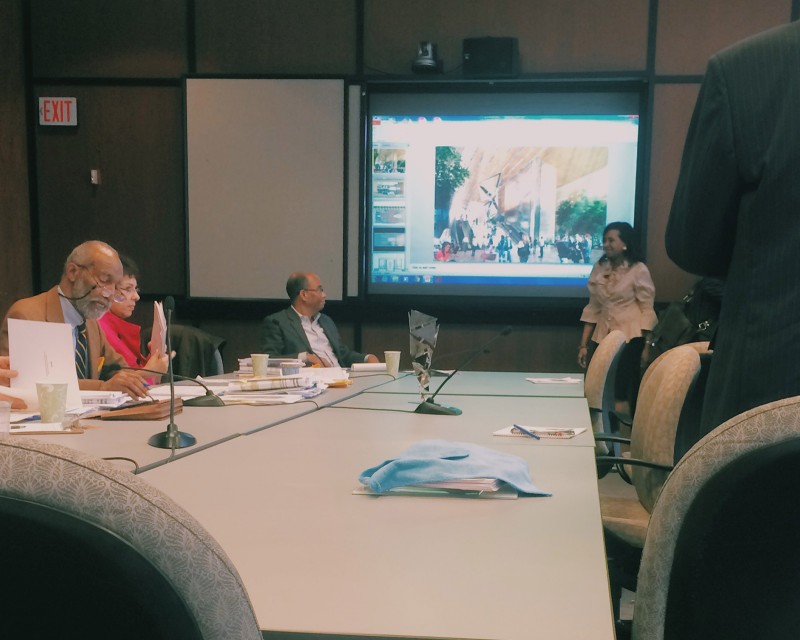
There is no limit to the number of proposals that the Philadelphia Art Commission will hear any given month. All full applications submitted by the deadline (two weeks before each meeting) will be heard. This policy typically results in a handful of projects up for hearings each month. This March, the Commission made a decision on 14 projects. Not all were new projects, but most were.
So what gives? Why so many projects? One possible explanation is that Philadelphia is in the midst of a development boom. Walk around Center City and you will surely bump into another new construction site. It’s one thing to notice it, but let’s look at the record to see if we may quantify it. The agendas of Art Commission past over the last four years provided this basic count of projects under review.

The data confirms a steady increase in new projects going before the Art Commission. This rapid redevelopment in Philadelphia owes to a number of complex and overlapping factors. There’s the slew of recent high-profile national and international events, like Pope Francis’ visit, the Forbes Under 30 summit, and the upcoming Democratic National Convention. There are the recent travel distinctions, like Philadelphia ranking third on New York Times’ top 2015 travel destinations, and being named the nation’s first Unesco World Heritage site. Both of which are, anecdotally, bringing a new wave of tourists and transplants. So for better or worse, our next wave of redevelopment is feeding itself.
As a result, the March 2016 Art Commission meeting moved at a rapid pace, and still lasted over 4 hours. With an unprecedented number of projects reviewed, it seemed most appropriate to hand out awards—to the projects and to the participants. An honorable mention goes to the beleaguered, but still effective, members of this Commission.
Best loophole for arts and culture
In October 2015, the City approved a measure to provide 600 new digital advertising bus shelters throughout Philadelphia. Although the new agreement eliminated a 1983 agreement to provide exclusive access to low-cost advertising on bus shelters along Walnut Street, it called for 100 two-sided “arts information kiosks” to be installed on Walnut Street.
And what are rules then, without enforcement? Kudos to chairman Emmanuel Kelly for recalling this agreement and advising the group seeking approval on a new bus shelter design that “if it’s a digital advertisement, then one side must be dedicated to culture.” Or put another way, while one supposes the world is trending towards more screens, we’ll be damned if we lose our arts.
Best contempt of proposed cost savings
Buell Kratzer Powell returned to present a change to their approved design of the 5th Police District building. Citing budget concerns, BKP shared a design that separated ADA access by means of an ADA elevator, to the right of the stairwell entrance. The Commission was not happy. Responding that this design reaffirms the status of the disabled as “second-class” citizens, they asked the group to withdraw the submission, rather than having the Commission reject it. “Police stations are evolving into places where people have meetings. They need to be more accessible,” said Emanuel Kelly. And when learning of the cost savings of $50-75,000, Kelly responded, “Pffffft. That’s peanuts.”

Most surprising new artwork from the Big Bad Wolf
In a day’s proceedings where the Commission reminded everyone that they had 10 minutes, this presentation by the Comcast Center was the first to break this rhythm. First, was a lengthy explanation of the reason to appear before the commission, atypical for a building on private land with private funds. The % ordinance of the Redevelopment Authority requires it, as the Comcast Center will receive (and match) city funds to renovate the SEPTA station near the new tower. Then, Conrad Shawcross, an award-winning British artist, spoke at length about past works and context (another surprise in a day of hurried presentations). He showed an impressive body of work of geometry, engineering, scale, and technology. The proposed new work, an emerging and top-heavy mirrored tetrahedron engineered to have the smallest base possible, was a great fit for the new atrium of the Comcast Center, and thus, a pleasant surprise for a company with notoriously terrible customer service.

Most questionable justification: “It won’t happen here”
Artists Marianne Lovink and Scott Eunson presented a new proposal entitled “Nexus,” designed for the 40th Street subway station entrances and SEPTA’s Art in Transit program. Their installation re-imagines a distorted city grid, with unique colors (“energies of the city” to the artists) to identify each street corner of the subway entrances. Some members of the Commission were concerned about the collection of refuse—cups and other trash collecting in the work. The artists responded that this typically doesn’t happen to artwork, and others spoke of an improving neighborhood, with higher foot traffic that would discourage this behavior. Another presenter spoke up to say that this “neighborhood is not what it once was,” and so trash would not be a concern. No one offered to increase staff presence, or simply provide more trash and recycling at the site to curb the problem. Score one for the gentrification of University City being reason enough to address this concern.
Congrats on finding the treasure
The meeting concluded with four New Percent for Art proposals for renovations at the Lovett, Logan, Tacony, and Marrero public libraries. The artist selections represented a diverse range of artists, from recent Pew Fellow Ben Volta, to folk artist Ife Ni’owoo. With four projects at one meeting, one must assume that the Free Library recently found a treasure map in its archive, followed it to the “X,” and found a full chest of treasure.
Actually, this boom of library construction is linked to the Free Library’s recent success with its Building Inspiration: 21st Century Libraries Initiative, which has been the recipient of a $25 million grant from the William Penn Foundation, and another $1.25 million from the Knight Foundation, specifically for the Lovett library—just enough to trigger a 1% for art opportunity.









